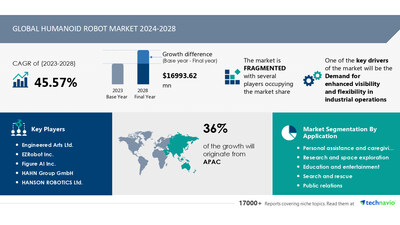
NEW YORK, Nov. 19, 2024 /PRNewswire/ — Report with the AI impact on market trends – The global humanoid robot market size is estimated to grow by USD 16.99 billion from 2024-2028, according to Technavio. The market is estimated to grow at a CAGR of 45.57% during the forecast period. Demand for enhanced visibility and flexibility in industrial operations is driving market growth, with a trend towards growing demand of humanoid robot owing to emergence of smart manufacturing. However, ethical issues with humanoid robots poses a challenge.Key market players include Engineered Arts Ltd., EZRobot Inc., Figure AI Inc., HAHN Group GmbH, HANSON ROBOTICS Ltd., Hasbro Inc., Honda Motor Co. Ltd., Hyundai Motor Co., Invento Research Inc., Kawada Robotics Co. Ltd., Macco Robotics, PAL Robotics, Promobot LLC, ROBO GARAGE CO. LTD., Robosen Technologies Ltd, ROBOTIS Co. Ltd, Toyota Motor Corp., Trossen Robotics, UBTECH Robotics Inc., and United Robotics Group GmbH.
Key insights into market evolution with AI-powered analysis. Explore trends, segmentation, and growth drivers- View Free Sample PDF
|
Humanoid Robot Market Scope |
|
|
Report Coverage |
Details |
|
Base year |
2023 |
|
Historic period |
2018 – 2022 |
|
Forecast period |
2024-2028 |
|
Growth momentum & CAGR |
Accelerate at a CAGR of 45.57% |
|
Market growth 2024-2028 |
USD 16993.62 million |
|
Market structure |
Fragmented |
|
YoY growth 2022-2023 (%) |
44.15 |
|
Regional analysis |
North America, APAC, Europe, Middle East and Africa, and South America |
|
Performing market contribution |
APAC at 36% |
|
Key countries |
US, Japan, China, South Korea, and Germany |
|
Key companies profiled |
Engineered Arts Ltd., EZRobot Inc., Figure AI Inc., HAHN Group GmbH, HANSON ROBOTICS Ltd., Hasbro Inc., Honda Motor Co. Ltd., Hyundai Motor Co., Invento Research Inc., Kawada Robotics Co. Ltd., Macco Robotics, PAL Robotics, Promobot LLC, ROBO GARAGE CO. LTD., Robosen Technologies Ltd, ROBOTIS Co. Ltd, Toyota Motor Corp., Trossen Robotics, UBTECH Robotics Inc., and United Robotics Group GmbH |
Market Driver
The humanoid robot market is experiencing significant growth, driven by trends in AI for good, aerospace, and assisted living. Companies like Ameca in Jalisco are leading the charge with autonomous robots for elder care and exploration. In the aerospace industry, humanoid robots are being used for astronaut assistance and autonomous exploration. In the amusement park sector, humanoid robots offer customer engagement and satisfaction through interactive experiences. Investment in humanoid robot technology is on the rise, with startups and established companies alike seeking to capitalize on its potential. Ansys simulation software and cognitive science are key areas of focus for innovation. Behavioral sciences, consciousness, and neuroscience are also important fields of study for creating more human-like robots. The marketplace for humanoid robots is diverse, with applications in grocery stores, hospitality, and even isolation wards. Robots are used for customer engagement, medication dispensing, and even surveillance. In the future, humanoid robots may be used for language translation, learning, and even music performance. Strategic management and policy are crucial for the successful implementation of humanoid robots in various industries. Subsidies and investment opportunities are available for companies in this field. Humanoid robots are being used in various industries such as healthcare, education, and manufacturing for tasks ranging from ultraviolet disinfection to autonomous elevator operation. Invention and training are ongoing processes in the humanoid robot market. Robots are being used for research in mathematics, science, and even rock music. Autonomous robots are being used in the aerospace industry for exploration, while humanoid robots are being used in assisted living for elderly care and motivation. The humanoid robot market is constantly evolving, with new applications and innovations emerging all the time. From autonomous elevators to cognitive science research, the potential for humanoid robots is vast. Whether it’s in the aerospace industry, a grocery store, or an isolation ward, humanoid robots are making a difference.
Smart manufacturing is a modern industrial approach that leverages advanced computing, analytics, and IoT-integrated technology to optimize production processes. Key objectives include flow optimization, customization, asset tracking, predictive maintenance, and real-time inventory management. The growth of automation, electrification, data integration, human-machine interaction, and connectivity have driven the adoption of smart manufacturing. In the automotive industry, sensors are used extensively in manufacturing, assembly lines, and warehouses to enable automation and improve efficiency. Industrial machines and robots are equipped with IoT-integrated microprocessors, microcontrollers, sensors, and switches to facilitate smart manufacturing.
Request Sample of our comprehensive report now to stay ahead in the AI-driven market evolution!
Market Challenges
- The humanoid robot market is experiencing significant growth as these advanced machines find applications in various industries. AI for Good initiatives, aerospace, and Ameca Robotics in Jalisco lead the charge in exploration and autonomous robotics. In the entertainment sector, amusement parks use humanoids for customer engagement and satisfaction. Ansys simulation software and cognitive science help develop robots capable of cognition and consciousness. Assisted living, elderly care, and hospitals utilize humanoids for duty in isolation wards and patient care. The future of humanoids includes investment in startups, autonomy in grocery stores and elevators, and even autonomous payment kiosks. Challenges include policy-making, language barriers, and ensuring relevance in areas like mathematics, medicine, and neuroscience. Humanoids are also being used for motivation in areas like music and art, and for strategic management in client computing and investment. Invention in areas like autonomous elevator systems and ultraviolet disinfection robots continue to push the boundaries of this exciting market.
- The humanoid robot market faces significant challenges due to ethical concerns. Unemployment is a major issue as humanoid robots can perform tasks previously done by laborers, leading to potential job losses. Ethical dilemmas also include privacy concerns, inaccurate data usage, and control and liability issues. These challenges may hinder the growth of the global humanoid robot market during the forecast period. It is crucial for businesses to address these ethical concerns to ensure the responsible adoption and integration of humanoid robots into various industries.
Discover how AI is revolutionizing market trends- Get your access now!
Segment Overview
This humanoid robot market report extensively covers market segmentation by
- Application
- 1.1 Personal assistance and caregiving
- 1.2 Research and space exploration
- 1.3 Education and entertainment
- 1.4 Search and rescue
- 1.5 Public relations
- Component
- 2.1 Hardware
- 2.2 Software
- Geography
- 3.1 North America
- 3.2 APAC
- 3.3 Europe
- 3.4 Middle East and Africa
- 3.5 South America
1.1 Personal assistance and caregiving- The personal assistance and caregiving segment of the global humanoid robot market is experiencing notable growth due to the increasing demand for robots that can help people with daily living tasks and provide companionship and mental health support. Key players, such as HANSON ROBOTICS, Toyota, and PAL Robotics, are developing humanoid robots with diverse capabilities, from basic tasks to advanced functions like conversing and emotion recognition. The aging population, rising home care demands, and technological advancements fuel market expansion. Startups and smaller companies also contribute, offering specialized humanoid robots for specific applications, like autism therapy or mobility assistance. Overall, the personal assistance and caregiving segment’s growth will continue to drive the global humanoid robot market, as robots become increasingly capable and the need for caregiving services increases.
Download a Sample of our comprehensive report today to discover how AI-driven innovations are reshaping competitive dynamics
Research Analysis
The Humanoid Robot Market is experiencing rapid growth as advancements in AI, autonomy, and cognitive science drive innovation in various industries. Robots are being integrated into sectors such as aerospace for exploration and astronaut assistance, amusement parks for customer engagement, and assisted living for elderly care. In the future, humanoid robots are expected to revolutionize industries like grocery stores and hospitality, providing improved customer satisfaction and efficiency. Applications in fields like art, consciousness, and behavioral sciences are also emerging, broadening the scope of humanoid robotics. Companies are leveraging Ansys for simulation and design, while autonomous robots are being used in duty roles like elevators and electric generators. Foreign language capabilities add to their versatility, making humanoid robots an essential part of our future.
Market Research Overview
The Humanoid Robot Market is experiencing rapid growth as AI technology advances and robots become increasingly integrated into various industries. From ‘AI for Good’ projects to aerospace and amusement parks, humanoid robots are making waves in exploration, assisted living, and customer engagement. In the realm of art and behavioral sciences, robots are pushing boundaries in cognitive science, consciousness, and neuroscience. The marketplace also includes applications in manufacturing, such as autonomous robots for assembly lines and electric generators. In the future, humanoid robots will be found in grocery stores, hospitals, and even isolation wards, providing essential services with motivation and relevance. The market is driven by investment and policy, with startups and subsidies playing a significant role in innovation. Robots are also being used for payment systems, language translation, and even music composition. The possibilities are endless, from simulation software for strategic management to robots that can learn and adapt to their environment. The humanoid robot market is shaping the future of various industries and our daily lives.
Table of Contents:
1 Executive Summary
2 Market Landscape
3 Market Sizing
4 Historic Market Size
5 Five Forces Analysis
6 Market Segmentation
- Application
- Personal Assistance And Caregiving
- Research And Space Exploration
- Education And Entertainment
- Search And Rescue
- Public Relations
- Component
- Hardware
- Software
- Geography
- North America
- APAC
- Europe
- Middle East And Africa
- South America
7 Customer Landscape
8 Geographic Landscape
9 Drivers, Challenges, and Trends
10 Company Landscape
11 Company Analysis
12 Appendix
About Technavio
Technavio is a leading global technology research and advisory company. Their research and analysis focuses on emerging market trends and provides actionable insights to help businesses identify market opportunities and develop effective strategies to optimize their market positions.
With over 500 specialized analysts, Technavio’s report library consists of more than 17,000 reports and counting, covering 800 technologies, spanning across 50 countries. Their client base consists of enterprises of all sizes, including more than 100 Fortune 500 companies. This growing client base relies on Technavio’s comprehensive coverage, extensive research, and actionable market insights to identify opportunities in existing and potential markets and assess their competitive positions within changing market scenarios.
Contacts
Technavio Research
Jesse Maida
Media & Marketing Executive
US: +1 844 364 1100
UK: +44 203 893 3200
Email: [email protected]
Website: www.technavio.com/
View original content to download multimedia:https://www.prnewswire.com/news-releases/humanoid-robot-market-to-grow-by-usd-16-99-billion-2024-2028-driven-by-demand-for-enhanced-industrial-visibility-and-flexibility-with-ai-driving-market-transformation—technavio-302309660.html
SOURCE Technavio






